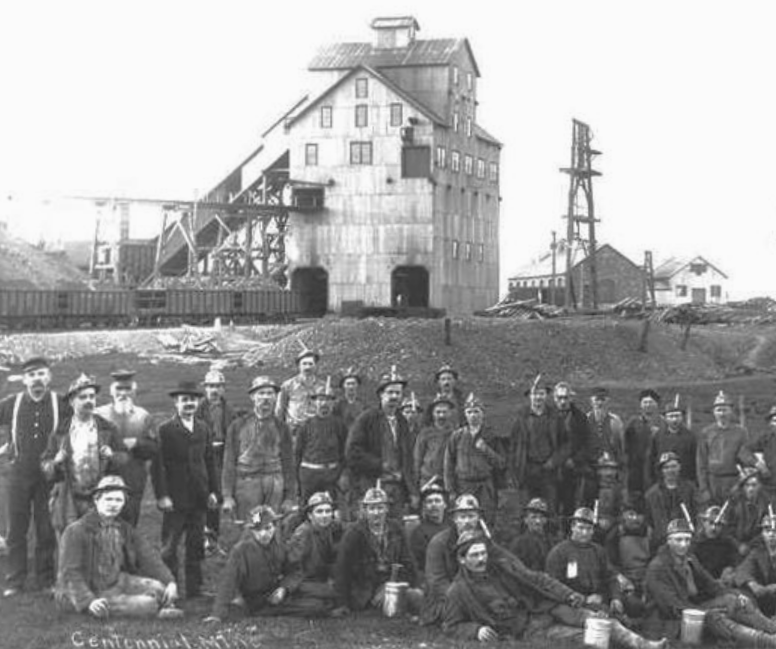- Details
- Hits: 2559
Mine: Centennial Mine, Centennial Heights, MI
Schoolcraft Mine → Centennial Mine → Closed (C&H)
Operated for 103 years including closures.
From: 1863
Owned by: Centennial Mining Company in 1876, then Centennial Copper Co. in 1896, later C&H control.
Produced: Copper Ore
Method: Shafts (7)
Railroad connection: Mineral Range railroad, then Hecla & Torch Lake railroad (C&H)
Stamp Mill/Smelter: Arcadian Mill; Centennial Mill
Until: 1930's depression. Later until 1966.
Lifetime Production:
Bankrupt in 1873. Reopened in 1876 as Centennial Mine.
 Image info: An early 1900's view of miners posing in front of the Centennial Mine in Calumet Township. Railroad cars are loading at the frame house.
Image info: An early 1900's view of miners posing in front of the Centennial Mine in Calumet Township. Railroad cars are loading at the frame house.
Notes
Seven shafts over time. No. 2 was most productive. No. 2 continued until 1966 when closed by C&H. [CCE]
An underground copper mine consisting of 7 incline shafts near the community of Centennial, just north of Calumet. The Schoolcraft Mining Co. was organized in 1863 and worked the Calumet Conglomerate in a small scale operation until it went bankrupt in 1873. In 1876, the Centennial Mining Co. organized on the previously owned Schoolcraft property and worked the Osceola Amygdaloid until 1896, at which time the company re-organized as the Centennial Copper Co. Work was discontinued on the Calumet Conglomerate and the Osceola Amygdaloid and two new incline shafts were driven on the Kearsarge Amygdaloid. In 1923, Calumet and Hecla took control of the mine and operated it until 1931 when it closed. In 1944, shaft #2 was reopened and operated until 1966 when the mine closed for good. Before C&H took control, the Centennial Mine produced approximately 37 million lbs. of refined copper. [MINDAT]
Centennial Mine was a copper mine located north of Red Jacket/Calumet in Houghton County. Operations began in 1869 and ultimately included seven inclined shafts. Centennial was reported to not have been a profitable operation. The mine was organized by the Centennial Mining Company in 1896 and began working the Kearsarge Load in 1899. Controlling interest passed to the C&H Company in 1907 and then merged with them in 1923.
Shaft #1 & 2 were located east of US-41 and M-26. [UPM] NW 1/4 of Section 18 of T45N-R33W. [DMP]
Shaft #3 had a steam-driven Lidgerwald hoist dating from about 1890. Another hoist was at this location, a steam-driven hoist c. 1900 originally located at the Colorado mine, then Tamarack shaft #5 before being moved to Centennial #3. It was modified to be driven by a GE 500 hp 2,200 v 125 a unit which operates at 442 rpm. [UPM] SE 1/4 Section 12 of T56N-R33W. [DMP]
Time Line
1907. February. Rock shipments from the Centennial mine to its mill at Grosse Pointe are again normal. The company lost 13 days last month because of bad weather and the inability of the Mineral Range railroad to cope with conditions. As soon as No. 2 shaft goes into commission there will be a large increase in production. [DFP-1907-0224]
1923. The Ahmeek, Allouez, Centenial, Osceola and C&H mining companies were merged into the Calumet & Hecla Consoldated Copper Company. The first four properties had been served by the Mineral Range railroad which was considered expensive. A right-of-way along the Trap Rock River valley was secured and construction begun in June 1924. [CRR]
1965. Reported as an active mines in #2, #3 and #6 shafts. Operated by Calumet & Hecla Inc. [DMP]

